Evaluating Supply Chain and Revenue in Australian Retail
VerifiedAdded on 2021/06/15
|18
|4291
|60
Project
AI Summary
This professional project investigates the relationship between supply chain management and revenue generation within the Australian retail industry. The research examines the competitive landscape, focusing on market leaders like Woolworths and Coles, along with emerging players like ALDI and Metcash. The study aims to identify the impact of supply chain practices on revenue, analyzing elements like supply chain configuration, relationship management, and coordination. Through a critical literature review and secondary data analysis, the project explores how factors such as cost reduction, technological innovation, and consumer satisfaction influence revenue generation. The project employs a positivist, deductive approach, utilizing a conclusive research design to derive practical recommendations for improving supply chain management and achieving long-term sustainability and competitive advantage in the dynamic Australian retail market. The study concludes that there is a positive relationship between supply chain management and revenue generation.
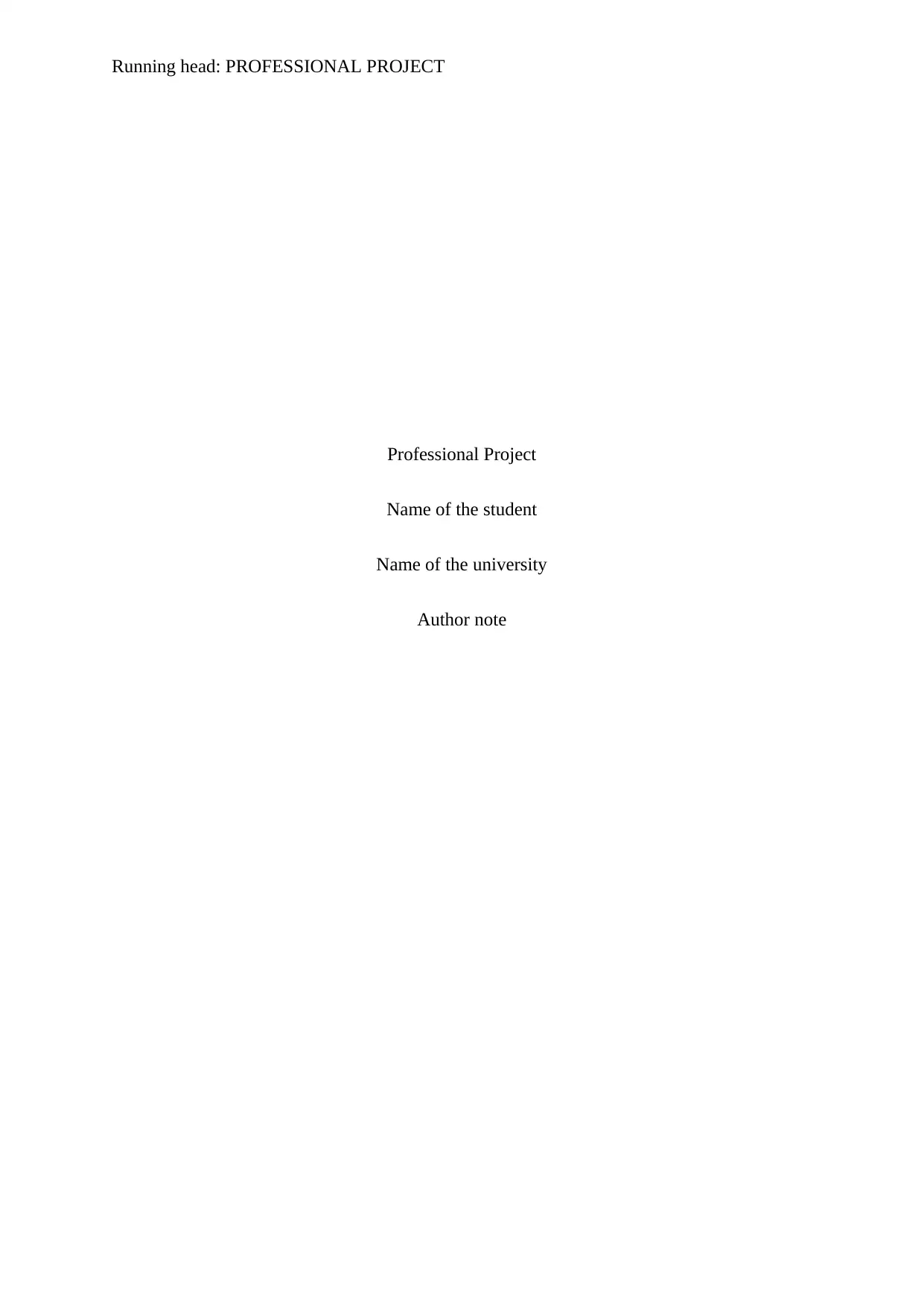
Running head: PROFESSIONAL PROJECT
Professional Project
Name of the student
Name of the university
Author note
Professional Project
Name of the student
Name of the university
Author note
Paraphrase This Document
Need a fresh take? Get an instant paraphrase of this document with our AI Paraphraser
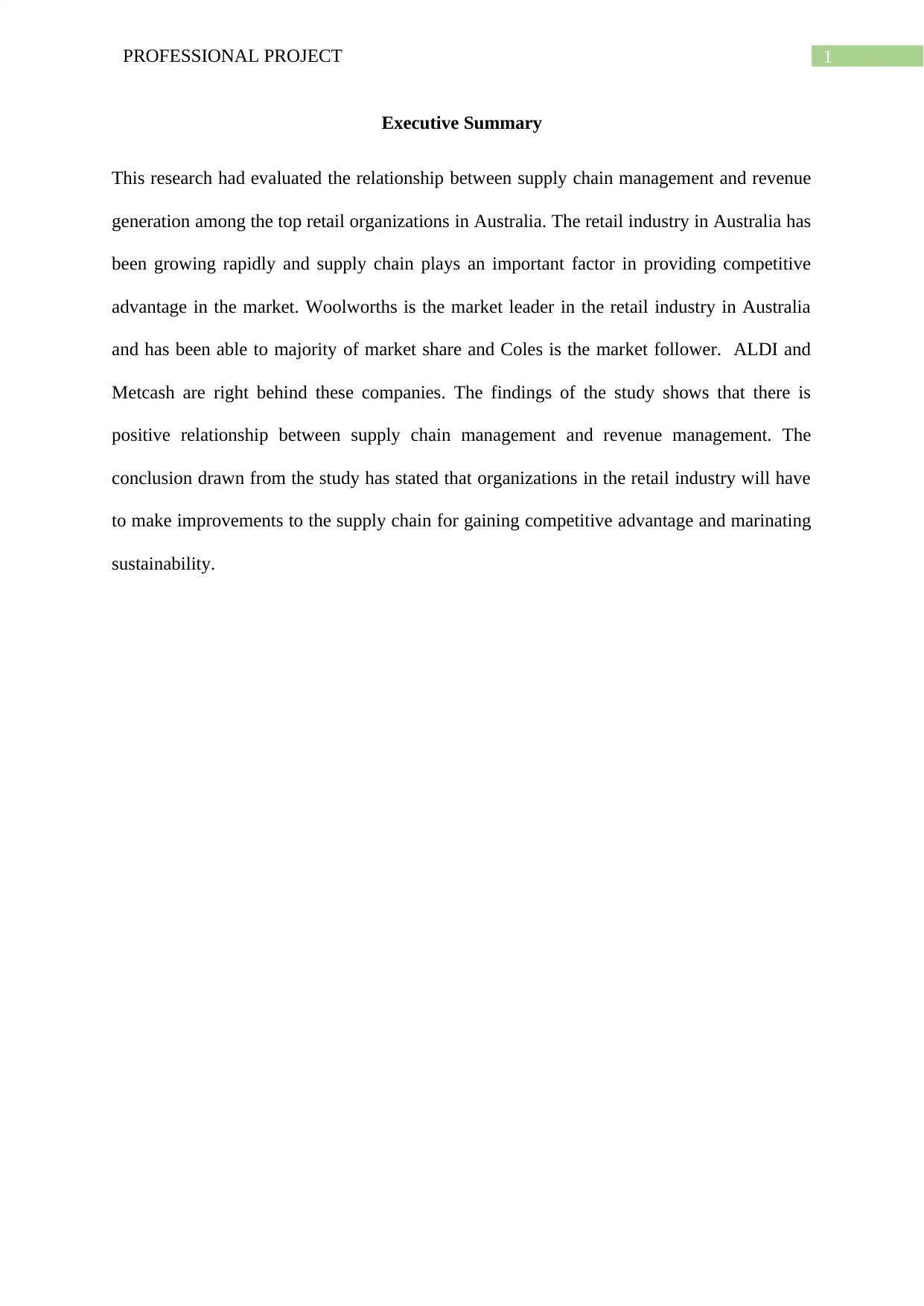
1PROFESSIONAL PROJECT
Executive Summary
This research had evaluated the relationship between supply chain management and revenue
generation among the top retail organizations in Australia. The retail industry in Australia has
been growing rapidly and supply chain plays an important factor in providing competitive
advantage in the market. Woolworths is the market leader in the retail industry in Australia
and has been able to majority of market share and Coles is the market follower. ALDI and
Metcash are right behind these companies. The findings of the study shows that there is
positive relationship between supply chain management and revenue management. The
conclusion drawn from the study has stated that organizations in the retail industry will have
to make improvements to the supply chain for gaining competitive advantage and marinating
sustainability.
Executive Summary
This research had evaluated the relationship between supply chain management and revenue
generation among the top retail organizations in Australia. The retail industry in Australia has
been growing rapidly and supply chain plays an important factor in providing competitive
advantage in the market. Woolworths is the market leader in the retail industry in Australia
and has been able to majority of market share and Coles is the market follower. ALDI and
Metcash are right behind these companies. The findings of the study shows that there is
positive relationship between supply chain management and revenue management. The
conclusion drawn from the study has stated that organizations in the retail industry will have
to make improvements to the supply chain for gaining competitive advantage and marinating
sustainability.
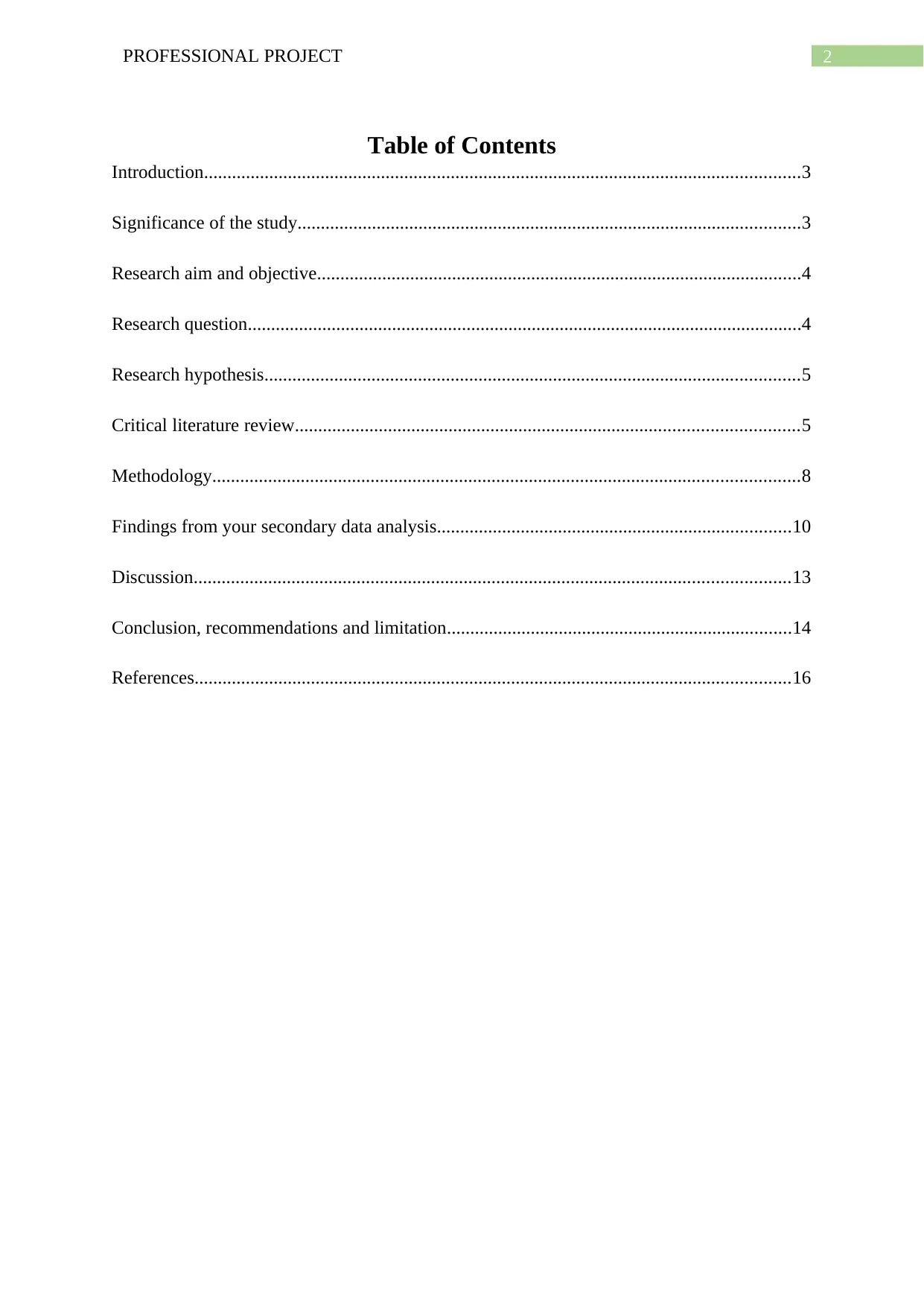
2PROFESSIONAL PROJECT
Table of Contents
Introduction................................................................................................................................3
Significance of the study............................................................................................................3
Research aim and objective........................................................................................................4
Research question.......................................................................................................................4
Research hypothesis...................................................................................................................5
Critical literature review............................................................................................................5
Methodology..............................................................................................................................8
Findings from your secondary data analysis............................................................................10
Discussion................................................................................................................................13
Conclusion, recommendations and limitation..........................................................................14
References................................................................................................................................16
Table of Contents
Introduction................................................................................................................................3
Significance of the study............................................................................................................3
Research aim and objective........................................................................................................4
Research question.......................................................................................................................4
Research hypothesis...................................................................................................................5
Critical literature review............................................................................................................5
Methodology..............................................................................................................................8
Findings from your secondary data analysis............................................................................10
Discussion................................................................................................................................13
Conclusion, recommendations and limitation..........................................................................14
References................................................................................................................................16
⊘ This is a preview!⊘
Do you want full access?
Subscribe today to unlock all pages.

Trusted by 1+ million students worldwide
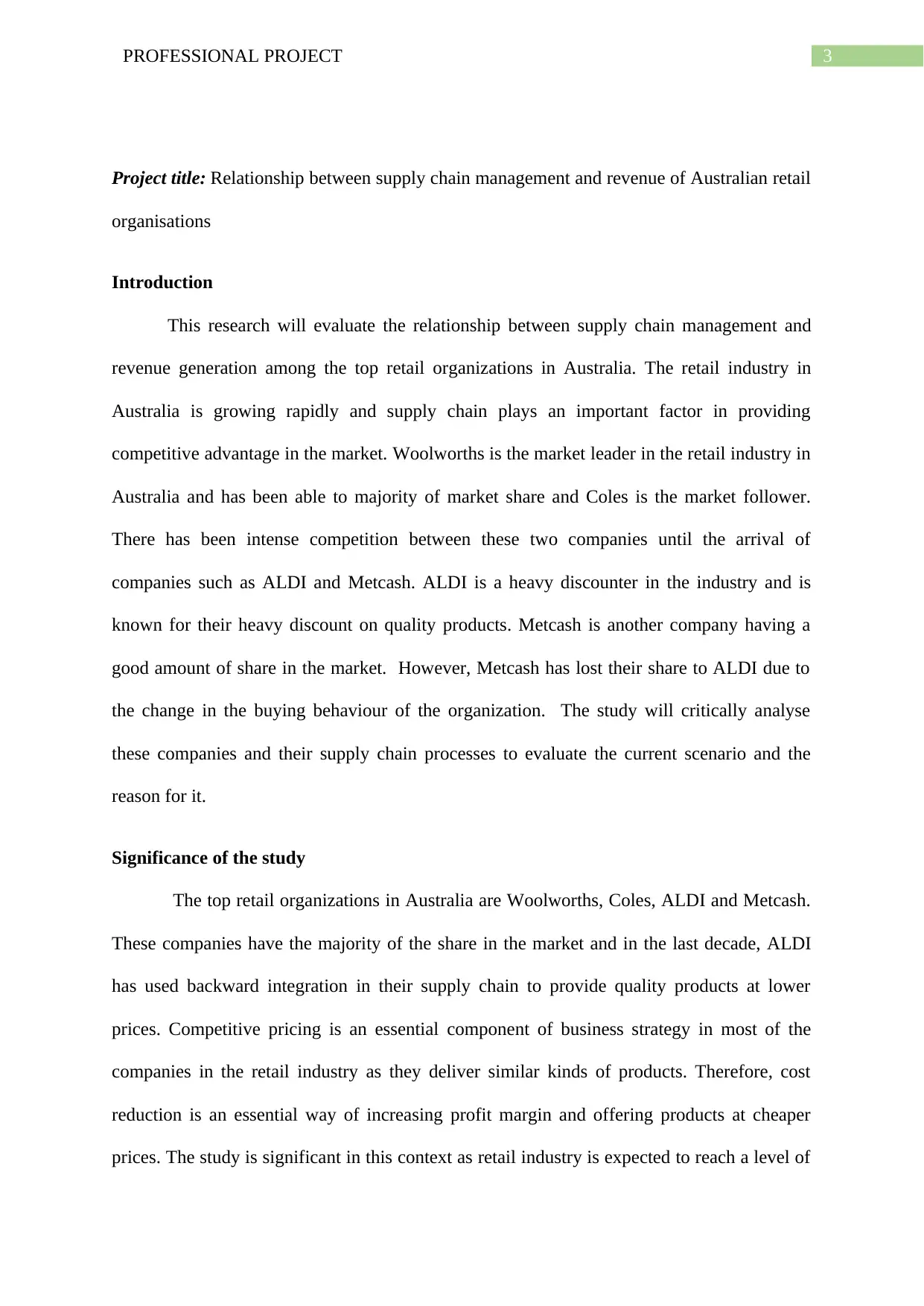
3PROFESSIONAL PROJECT
Project title: Relationship between supply chain management and revenue of Australian retail
organisations
Introduction
This research will evaluate the relationship between supply chain management and
revenue generation among the top retail organizations in Australia. The retail industry in
Australia is growing rapidly and supply chain plays an important factor in providing
competitive advantage in the market. Woolworths is the market leader in the retail industry in
Australia and has been able to majority of market share and Coles is the market follower.
There has been intense competition between these two companies until the arrival of
companies such as ALDI and Metcash. ALDI is a heavy discounter in the industry and is
known for their heavy discount on quality products. Metcash is another company having a
good amount of share in the market. However, Metcash has lost their share to ALDI due to
the change in the buying behaviour of the organization. The study will critically analyse
these companies and their supply chain processes to evaluate the current scenario and the
reason for it.
Significance of the study
The top retail organizations in Australia are Woolworths, Coles, ALDI and Metcash.
These companies have the majority of the share in the market and in the last decade, ALDI
has used backward integration in their supply chain to provide quality products at lower
prices. Competitive pricing is an essential component of business strategy in most of the
companies in the retail industry as they deliver similar kinds of products. Therefore, cost
reduction is an essential way of increasing profit margin and offering products at cheaper
prices. The study is significant in this context as retail industry is expected to reach a level of
Project title: Relationship between supply chain management and revenue of Australian retail
organisations
Introduction
This research will evaluate the relationship between supply chain management and
revenue generation among the top retail organizations in Australia. The retail industry in
Australia is growing rapidly and supply chain plays an important factor in providing
competitive advantage in the market. Woolworths is the market leader in the retail industry in
Australia and has been able to majority of market share and Coles is the market follower.
There has been intense competition between these two companies until the arrival of
companies such as ALDI and Metcash. ALDI is a heavy discounter in the industry and is
known for their heavy discount on quality products. Metcash is another company having a
good amount of share in the market. However, Metcash has lost their share to ALDI due to
the change in the buying behaviour of the organization. The study will critically analyse
these companies and their supply chain processes to evaluate the current scenario and the
reason for it.
Significance of the study
The top retail organizations in Australia are Woolworths, Coles, ALDI and Metcash.
These companies have the majority of the share in the market and in the last decade, ALDI
has used backward integration in their supply chain to provide quality products at lower
prices. Competitive pricing is an essential component of business strategy in most of the
companies in the retail industry as they deliver similar kinds of products. Therefore, cost
reduction is an essential way of increasing profit margin and offering products at cheaper
prices. The study is significant in this context as retail industry is expected to reach a level of
Paraphrase This Document
Need a fresh take? Get an instant paraphrase of this document with our AI Paraphraser
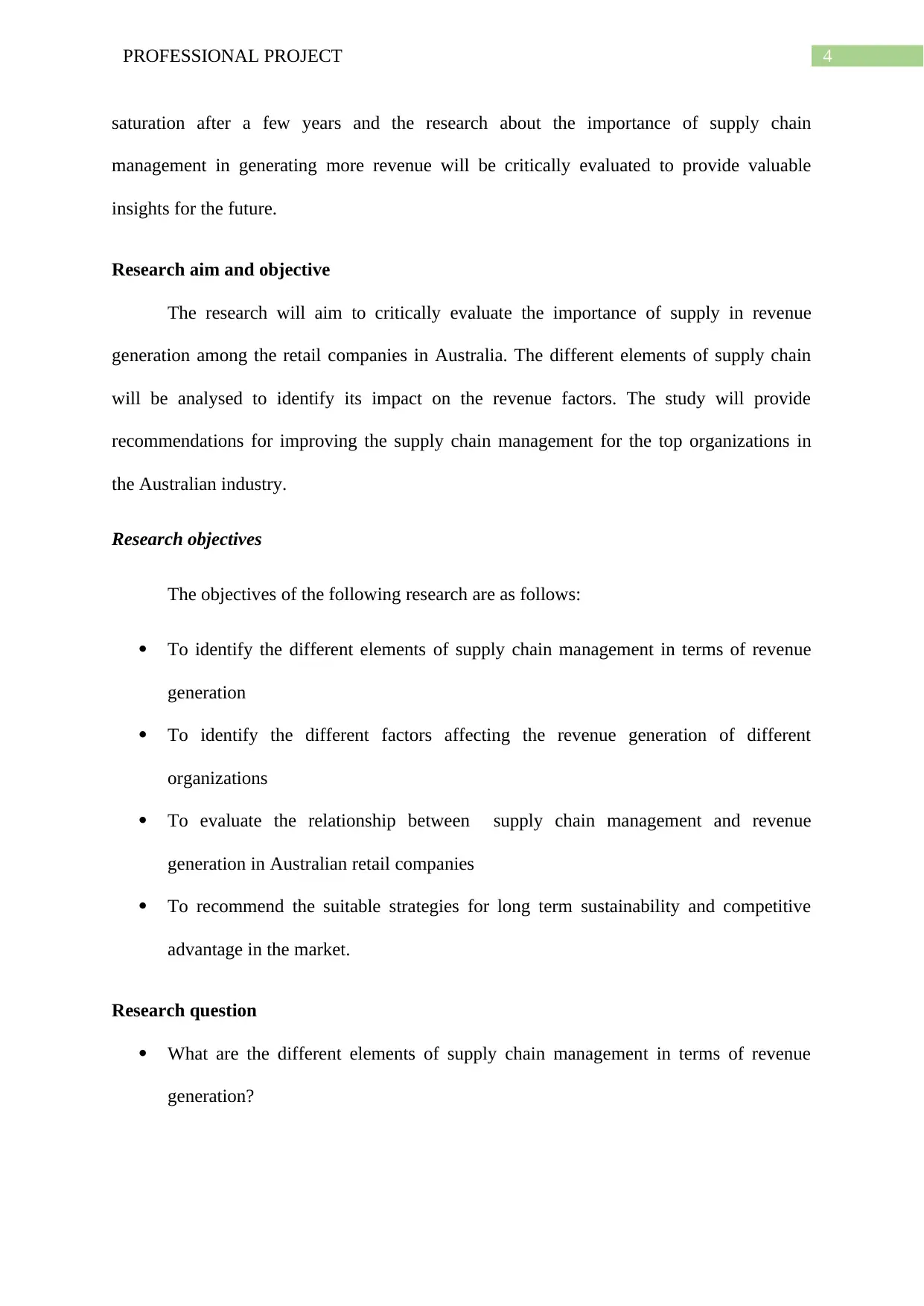
4PROFESSIONAL PROJECT
saturation after a few years and the research about the importance of supply chain
management in generating more revenue will be critically evaluated to provide valuable
insights for the future.
Research aim and objective
The research will aim to critically evaluate the importance of supply in revenue
generation among the retail companies in Australia. The different elements of supply chain
will be analysed to identify its impact on the revenue factors. The study will provide
recommendations for improving the supply chain management for the top organizations in
the Australian industry.
Research objectives
The objectives of the following research are as follows:
To identify the different elements of supply chain management in terms of revenue
generation
To identify the different factors affecting the revenue generation of different
organizations
To evaluate the relationship between supply chain management and revenue
generation in Australian retail companies
To recommend the suitable strategies for long term sustainability and competitive
advantage in the market.
Research question
What are the different elements of supply chain management in terms of revenue
generation?
saturation after a few years and the research about the importance of supply chain
management in generating more revenue will be critically evaluated to provide valuable
insights for the future.
Research aim and objective
The research will aim to critically evaluate the importance of supply in revenue
generation among the retail companies in Australia. The different elements of supply chain
will be analysed to identify its impact on the revenue factors. The study will provide
recommendations for improving the supply chain management for the top organizations in
the Australian industry.
Research objectives
The objectives of the following research are as follows:
To identify the different elements of supply chain management in terms of revenue
generation
To identify the different factors affecting the revenue generation of different
organizations
To evaluate the relationship between supply chain management and revenue
generation in Australian retail companies
To recommend the suitable strategies for long term sustainability and competitive
advantage in the market.
Research question
What are the different elements of supply chain management in terms of revenue
generation?
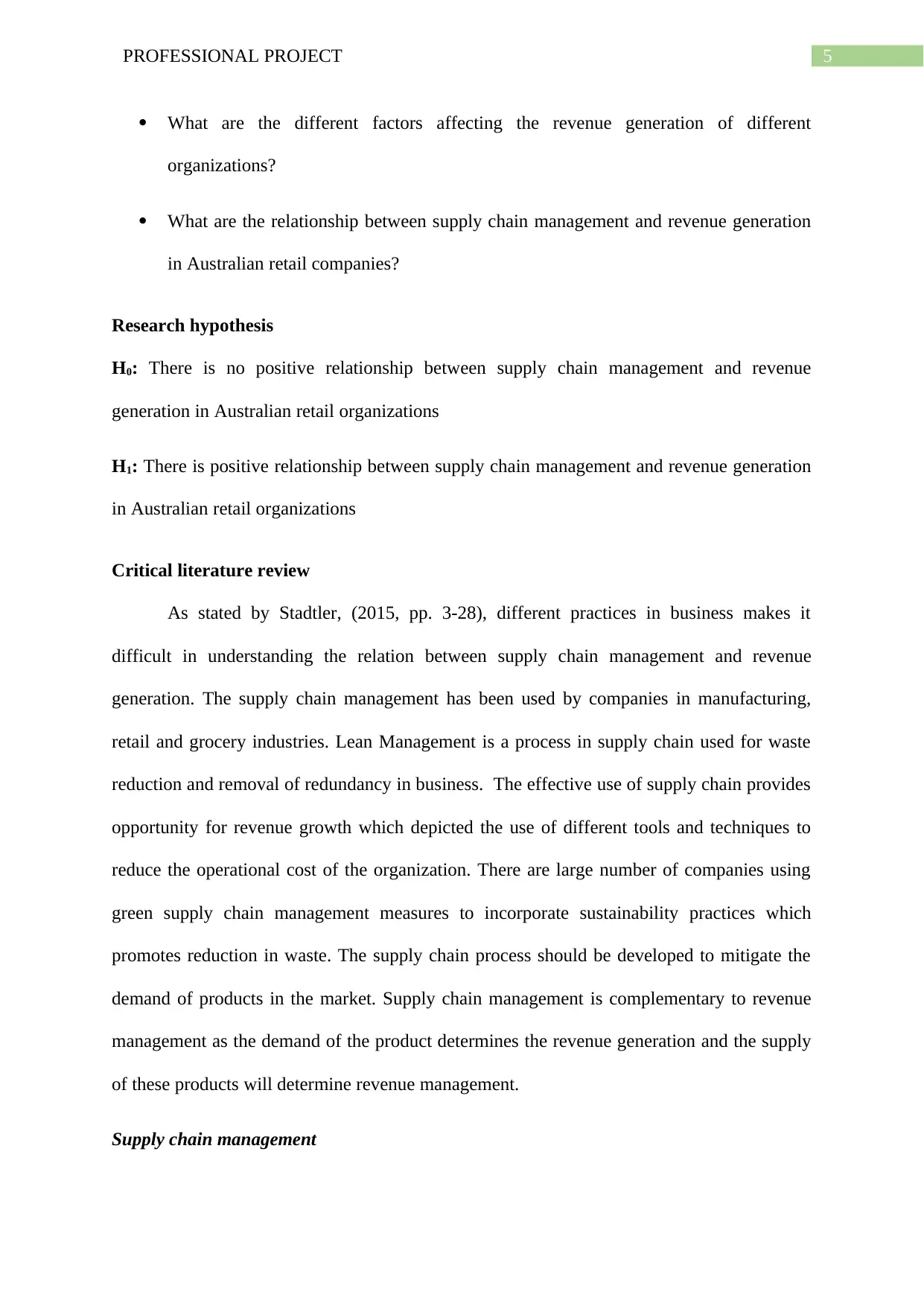
5PROFESSIONAL PROJECT
What are the different factors affecting the revenue generation of different
organizations?
What are the relationship between supply chain management and revenue generation
in Australian retail companies?
Research hypothesis
H0: There is no positive relationship between supply chain management and revenue
generation in Australian retail organizations
H1: There is positive relationship between supply chain management and revenue generation
in Australian retail organizations
Critical literature review
As stated by Stadtler, (2015, pp. 3-28), different practices in business makes it
difficult in understanding the relation between supply chain management and revenue
generation. The supply chain management has been used by companies in manufacturing,
retail and grocery industries. Lean Management is a process in supply chain used for waste
reduction and removal of redundancy in business. The effective use of supply chain provides
opportunity for revenue growth which depicted the use of different tools and techniques to
reduce the operational cost of the organization. There are large number of companies using
green supply chain management measures to incorporate sustainability practices which
promotes reduction in waste. The supply chain process should be developed to mitigate the
demand of products in the market. Supply chain management is complementary to revenue
management as the demand of the product determines the revenue generation and the supply
of these products will determine revenue management.
Supply chain management
What are the different factors affecting the revenue generation of different
organizations?
What are the relationship between supply chain management and revenue generation
in Australian retail companies?
Research hypothesis
H0: There is no positive relationship between supply chain management and revenue
generation in Australian retail organizations
H1: There is positive relationship between supply chain management and revenue generation
in Australian retail organizations
Critical literature review
As stated by Stadtler, (2015, pp. 3-28), different practices in business makes it
difficult in understanding the relation between supply chain management and revenue
generation. The supply chain management has been used by companies in manufacturing,
retail and grocery industries. Lean Management is a process in supply chain used for waste
reduction and removal of redundancy in business. The effective use of supply chain provides
opportunity for revenue growth which depicted the use of different tools and techniques to
reduce the operational cost of the organization. There are large number of companies using
green supply chain management measures to incorporate sustainability practices which
promotes reduction in waste. The supply chain process should be developed to mitigate the
demand of products in the market. Supply chain management is complementary to revenue
management as the demand of the product determines the revenue generation and the supply
of these products will determine revenue management.
Supply chain management
⊘ This is a preview!⊘
Do you want full access?
Subscribe today to unlock all pages.

Trusted by 1+ million students worldwide
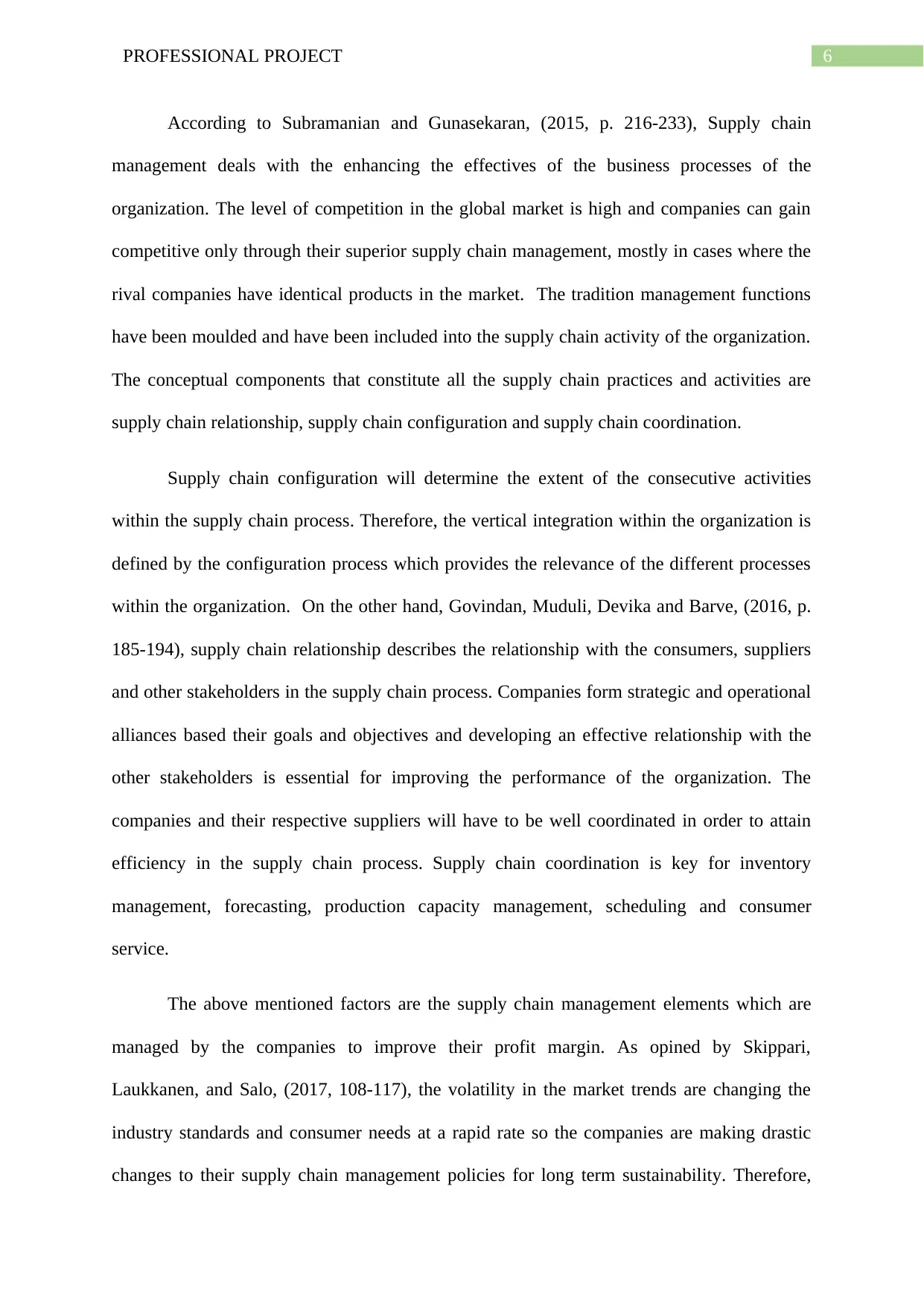
6PROFESSIONAL PROJECT
According to Subramanian and Gunasekaran, (2015, p. 216-233), Supply chain
management deals with the enhancing the effectives of the business processes of the
organization. The level of competition in the global market is high and companies can gain
competitive only through their superior supply chain management, mostly in cases where the
rival companies have identical products in the market. The tradition management functions
have been moulded and have been included into the supply chain activity of the organization.
The conceptual components that constitute all the supply chain practices and activities are
supply chain relationship, supply chain configuration and supply chain coordination.
Supply chain configuration will determine the extent of the consecutive activities
within the supply chain process. Therefore, the vertical integration within the organization is
defined by the configuration process which provides the relevance of the different processes
within the organization. On the other hand, Govindan, Muduli, Devika and Barve, (2016, p.
185-194), supply chain relationship describes the relationship with the consumers, suppliers
and other stakeholders in the supply chain process. Companies form strategic and operational
alliances based their goals and objectives and developing an effective relationship with the
other stakeholders is essential for improving the performance of the organization. The
companies and their respective suppliers will have to be well coordinated in order to attain
efficiency in the supply chain process. Supply chain coordination is key for inventory
management, forecasting, production capacity management, scheduling and consumer
service.
The above mentioned factors are the supply chain management elements which are
managed by the companies to improve their profit margin. As opined by Skippari,
Laukkanen, and Salo, (2017, 108-117), the volatility in the market trends are changing the
industry standards and consumer needs at a rapid rate so the companies are making drastic
changes to their supply chain management policies for long term sustainability. Therefore,
According to Subramanian and Gunasekaran, (2015, p. 216-233), Supply chain
management deals with the enhancing the effectives of the business processes of the
organization. The level of competition in the global market is high and companies can gain
competitive only through their superior supply chain management, mostly in cases where the
rival companies have identical products in the market. The tradition management functions
have been moulded and have been included into the supply chain activity of the organization.
The conceptual components that constitute all the supply chain practices and activities are
supply chain relationship, supply chain configuration and supply chain coordination.
Supply chain configuration will determine the extent of the consecutive activities
within the supply chain process. Therefore, the vertical integration within the organization is
defined by the configuration process which provides the relevance of the different processes
within the organization. On the other hand, Govindan, Muduli, Devika and Barve, (2016, p.
185-194), supply chain relationship describes the relationship with the consumers, suppliers
and other stakeholders in the supply chain process. Companies form strategic and operational
alliances based their goals and objectives and developing an effective relationship with the
other stakeholders is essential for improving the performance of the organization. The
companies and their respective suppliers will have to be well coordinated in order to attain
efficiency in the supply chain process. Supply chain coordination is key for inventory
management, forecasting, production capacity management, scheduling and consumer
service.
The above mentioned factors are the supply chain management elements which are
managed by the companies to improve their profit margin. As opined by Skippari,
Laukkanen, and Salo, (2017, 108-117), the volatility in the market trends are changing the
industry standards and consumer needs at a rapid rate so the companies are making drastic
changes to their supply chain management policies for long term sustainability. Therefore,
Paraphrase This Document
Need a fresh take? Get an instant paraphrase of this document with our AI Paraphraser
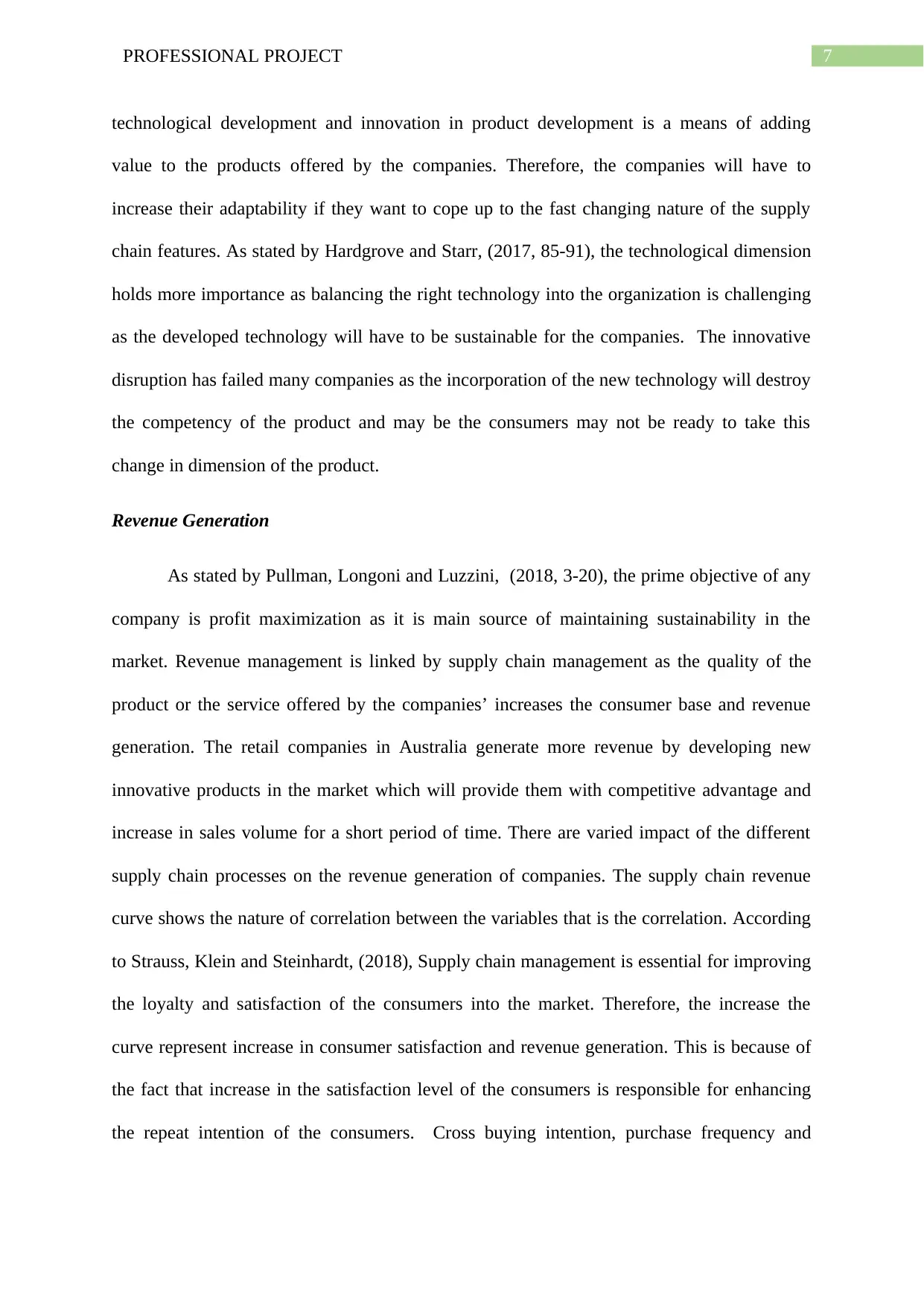
7PROFESSIONAL PROJECT
technological development and innovation in product development is a means of adding
value to the products offered by the companies. Therefore, the companies will have to
increase their adaptability if they want to cope up to the fast changing nature of the supply
chain features. As stated by Hardgrove and Starr, (2017, 85-91), the technological dimension
holds more importance as balancing the right technology into the organization is challenging
as the developed technology will have to be sustainable for the companies. The innovative
disruption has failed many companies as the incorporation of the new technology will destroy
the competency of the product and may be the consumers may not be ready to take this
change in dimension of the product.
Revenue Generation
As stated by Pullman, Longoni and Luzzini, (2018, 3-20), the prime objective of any
company is profit maximization as it is main source of maintaining sustainability in the
market. Revenue management is linked by supply chain management as the quality of the
product or the service offered by the companies’ increases the consumer base and revenue
generation. The retail companies in Australia generate more revenue by developing new
innovative products in the market which will provide them with competitive advantage and
increase in sales volume for a short period of time. There are varied impact of the different
supply chain processes on the revenue generation of companies. The supply chain revenue
curve shows the nature of correlation between the variables that is the correlation. According
to Strauss, Klein and Steinhardt, (2018), Supply chain management is essential for improving
the loyalty and satisfaction of the consumers into the market. Therefore, the increase the
curve represent increase in consumer satisfaction and revenue generation. This is because of
the fact that increase in the satisfaction level of the consumers is responsible for enhancing
the repeat intention of the consumers. Cross buying intention, purchase frequency and
technological development and innovation in product development is a means of adding
value to the products offered by the companies. Therefore, the companies will have to
increase their adaptability if they want to cope up to the fast changing nature of the supply
chain features. As stated by Hardgrove and Starr, (2017, 85-91), the technological dimension
holds more importance as balancing the right technology into the organization is challenging
as the developed technology will have to be sustainable for the companies. The innovative
disruption has failed many companies as the incorporation of the new technology will destroy
the competency of the product and may be the consumers may not be ready to take this
change in dimension of the product.
Revenue Generation
As stated by Pullman, Longoni and Luzzini, (2018, 3-20), the prime objective of any
company is profit maximization as it is main source of maintaining sustainability in the
market. Revenue management is linked by supply chain management as the quality of the
product or the service offered by the companies’ increases the consumer base and revenue
generation. The retail companies in Australia generate more revenue by developing new
innovative products in the market which will provide them with competitive advantage and
increase in sales volume for a short period of time. There are varied impact of the different
supply chain processes on the revenue generation of companies. The supply chain revenue
curve shows the nature of correlation between the variables that is the correlation. According
to Strauss, Klein and Steinhardt, (2018), Supply chain management is essential for improving
the loyalty and satisfaction of the consumers into the market. Therefore, the increase the
curve represent increase in consumer satisfaction and revenue generation. This is because of
the fact that increase in the satisfaction level of the consumers is responsible for enhancing
the repeat intention of the consumers. Cross buying intention, purchase frequency and
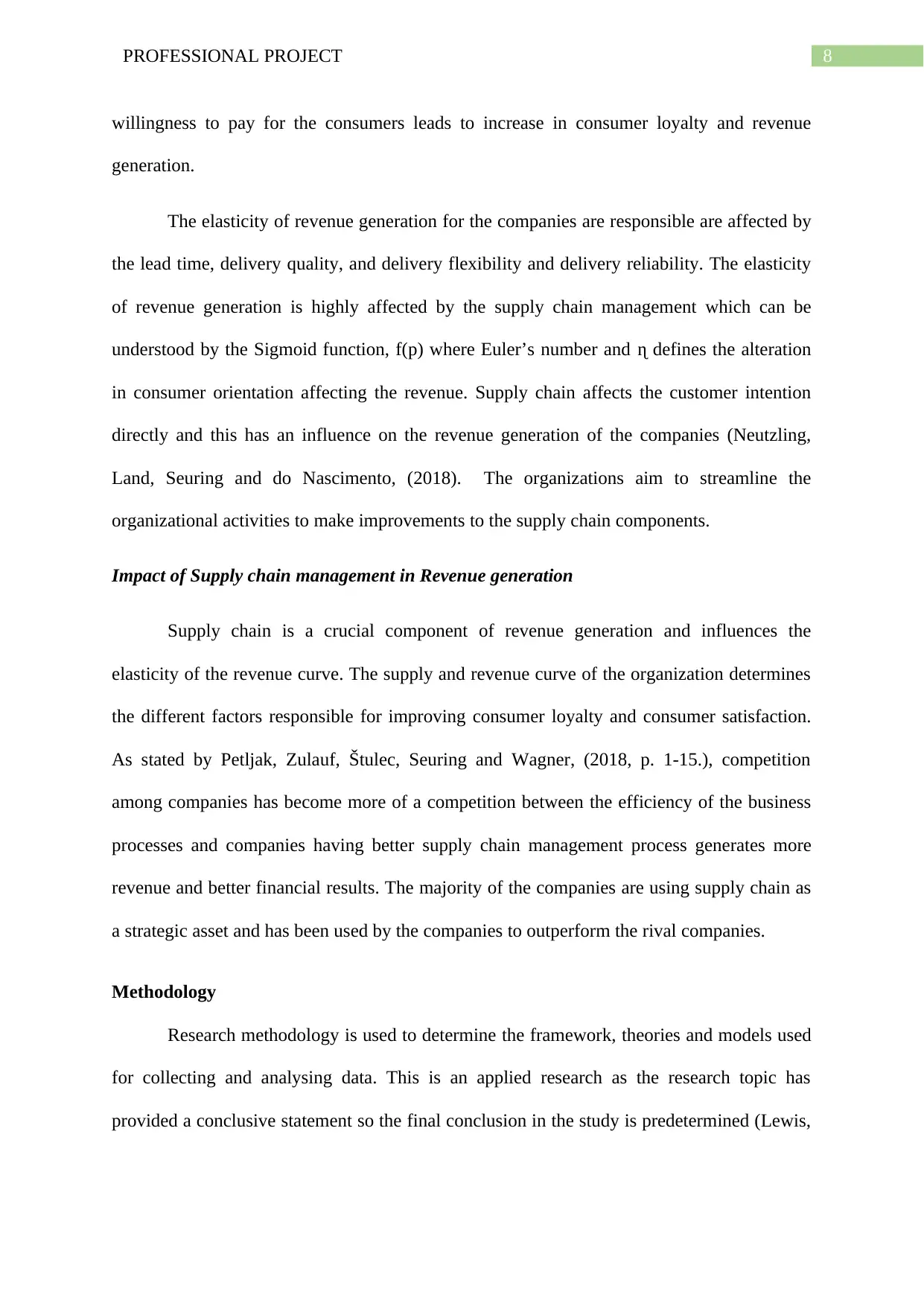
8PROFESSIONAL PROJECT
willingness to pay for the consumers leads to increase in consumer loyalty and revenue
generation.
The elasticity of revenue generation for the companies are responsible are affected by
the lead time, delivery quality, and delivery flexibility and delivery reliability. The elasticity
of revenue generation is highly affected by the supply chain management which can be
understood by the Sigmoid function, f(p) where Euler’s number and ɳ defines the alteration
in consumer orientation affecting the revenue. Supply chain affects the customer intention
directly and this has an influence on the revenue generation of the companies (Neutzling,
Land, Seuring and do Nascimento, (2018). The organizations aim to streamline the
organizational activities to make improvements to the supply chain components.
Impact of Supply chain management in Revenue generation
Supply chain is a crucial component of revenue generation and influences the
elasticity of the revenue curve. The supply and revenue curve of the organization determines
the different factors responsible for improving consumer loyalty and consumer satisfaction.
As stated by Petljak, Zulauf, Štulec, Seuring and Wagner, (2018, p. 1-15.), competition
among companies has become more of a competition between the efficiency of the business
processes and companies having better supply chain management process generates more
revenue and better financial results. The majority of the companies are using supply chain as
a strategic asset and has been used by the companies to outperform the rival companies.
Methodology
Research methodology is used to determine the framework, theories and models used
for collecting and analysing data. This is an applied research as the research topic has
provided a conclusive statement so the final conclusion in the study is predetermined (Lewis,
willingness to pay for the consumers leads to increase in consumer loyalty and revenue
generation.
The elasticity of revenue generation for the companies are responsible are affected by
the lead time, delivery quality, and delivery flexibility and delivery reliability. The elasticity
of revenue generation is highly affected by the supply chain management which can be
understood by the Sigmoid function, f(p) where Euler’s number and ɳ defines the alteration
in consumer orientation affecting the revenue. Supply chain affects the customer intention
directly and this has an influence on the revenue generation of the companies (Neutzling,
Land, Seuring and do Nascimento, (2018). The organizations aim to streamline the
organizational activities to make improvements to the supply chain components.
Impact of Supply chain management in Revenue generation
Supply chain is a crucial component of revenue generation and influences the
elasticity of the revenue curve. The supply and revenue curve of the organization determines
the different factors responsible for improving consumer loyalty and consumer satisfaction.
As stated by Petljak, Zulauf, Štulec, Seuring and Wagner, (2018, p. 1-15.), competition
among companies has become more of a competition between the efficiency of the business
processes and companies having better supply chain management process generates more
revenue and better financial results. The majority of the companies are using supply chain as
a strategic asset and has been used by the companies to outperform the rival companies.
Methodology
Research methodology is used to determine the framework, theories and models used
for collecting and analysing data. This is an applied research as the research topic has
provided a conclusive statement so the final conclusion in the study is predetermined (Lewis,
⊘ This is a preview!⊘
Do you want full access?
Subscribe today to unlock all pages.

Trusted by 1+ million students worldwide
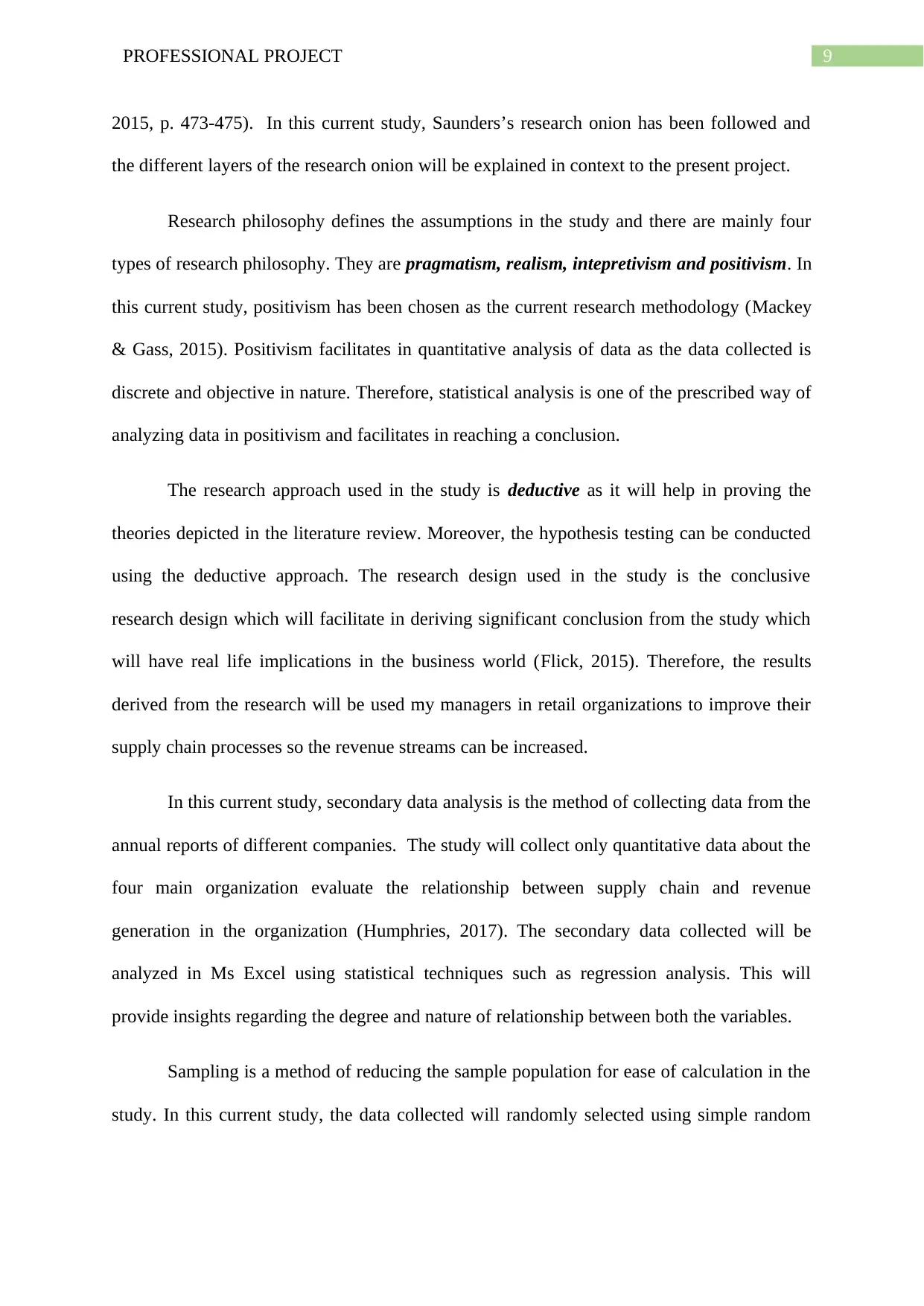
9PROFESSIONAL PROJECT
2015, p. 473-475). In this current study, Saunders’s research onion has been followed and
the different layers of the research onion will be explained in context to the present project.
Research philosophy defines the assumptions in the study and there are mainly four
types of research philosophy. They are pragmatism, realism, intepretivism and positivism. In
this current study, positivism has been chosen as the current research methodology (Mackey
& Gass, 2015). Positivism facilitates in quantitative analysis of data as the data collected is
discrete and objective in nature. Therefore, statistical analysis is one of the prescribed way of
analyzing data in positivism and facilitates in reaching a conclusion.
The research approach used in the study is deductive as it will help in proving the
theories depicted in the literature review. Moreover, the hypothesis testing can be conducted
using the deductive approach. The research design used in the study is the conclusive
research design which will facilitate in deriving significant conclusion from the study which
will have real life implications in the business world (Flick, 2015). Therefore, the results
derived from the research will be used my managers in retail organizations to improve their
supply chain processes so the revenue streams can be increased.
In this current study, secondary data analysis is the method of collecting data from the
annual reports of different companies. The study will collect only quantitative data about the
four main organization evaluate the relationship between supply chain and revenue
generation in the organization (Humphries, 2017). The secondary data collected will be
analyzed in Ms Excel using statistical techniques such as regression analysis. This will
provide insights regarding the degree and nature of relationship between both the variables.
Sampling is a method of reducing the sample population for ease of calculation in the
study. In this current study, the data collected will randomly selected using simple random
2015, p. 473-475). In this current study, Saunders’s research onion has been followed and
the different layers of the research onion will be explained in context to the present project.
Research philosophy defines the assumptions in the study and there are mainly four
types of research philosophy. They are pragmatism, realism, intepretivism and positivism. In
this current study, positivism has been chosen as the current research methodology (Mackey
& Gass, 2015). Positivism facilitates in quantitative analysis of data as the data collected is
discrete and objective in nature. Therefore, statistical analysis is one of the prescribed way of
analyzing data in positivism and facilitates in reaching a conclusion.
The research approach used in the study is deductive as it will help in proving the
theories depicted in the literature review. Moreover, the hypothesis testing can be conducted
using the deductive approach. The research design used in the study is the conclusive
research design which will facilitate in deriving significant conclusion from the study which
will have real life implications in the business world (Flick, 2015). Therefore, the results
derived from the research will be used my managers in retail organizations to improve their
supply chain processes so the revenue streams can be increased.
In this current study, secondary data analysis is the method of collecting data from the
annual reports of different companies. The study will collect only quantitative data about the
four main organization evaluate the relationship between supply chain and revenue
generation in the organization (Humphries, 2017). The secondary data collected will be
analyzed in Ms Excel using statistical techniques such as regression analysis. This will
provide insights regarding the degree and nature of relationship between both the variables.
Sampling is a method of reducing the sample population for ease of calculation in the
study. In this current study, the data collected will randomly selected using simple random
Paraphrase This Document
Need a fresh take? Get an instant paraphrase of this document with our AI Paraphraser
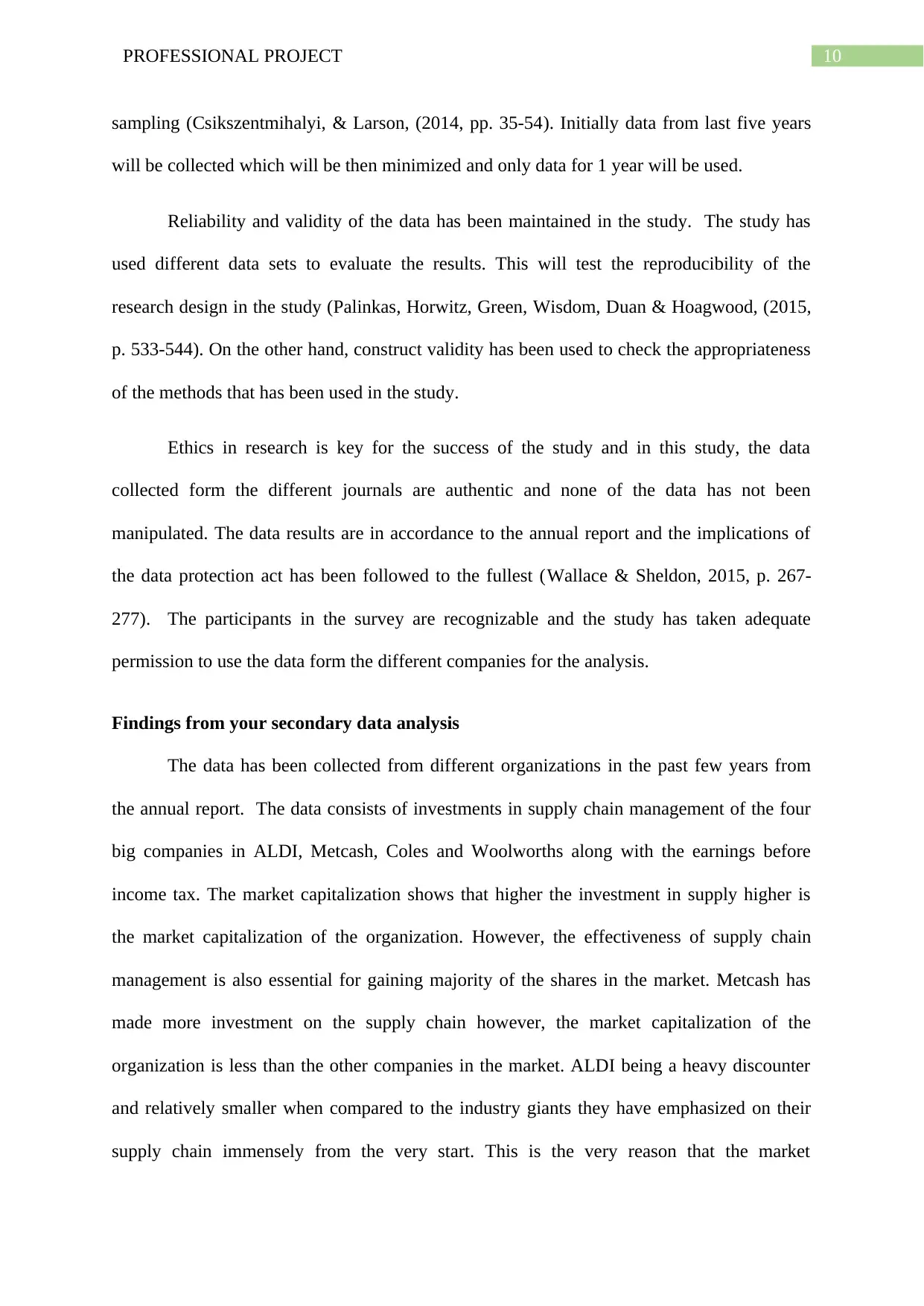
10PROFESSIONAL PROJECT
sampling (Csikszentmihalyi, & Larson, (2014, pp. 35-54). Initially data from last five years
will be collected which will be then minimized and only data for 1 year will be used.
Reliability and validity of the data has been maintained in the study. The study has
used different data sets to evaluate the results. This will test the reproducibility of the
research design in the study (Palinkas, Horwitz, Green, Wisdom, Duan & Hoagwood, (2015,
p. 533-544). On the other hand, construct validity has been used to check the appropriateness
of the methods that has been used in the study.
Ethics in research is key for the success of the study and in this study, the data
collected form the different journals are authentic and none of the data has not been
manipulated. The data results are in accordance to the annual report and the implications of
the data protection act has been followed to the fullest (Wallace & Sheldon, 2015, p. 267-
277). The participants in the survey are recognizable and the study has taken adequate
permission to use the data form the different companies for the analysis.
Findings from your secondary data analysis
The data has been collected from different organizations in the past few years from
the annual report. The data consists of investments in supply chain management of the four
big companies in ALDI, Metcash, Coles and Woolworths along with the earnings before
income tax. The market capitalization shows that higher the investment in supply higher is
the market capitalization of the organization. However, the effectiveness of supply chain
management is also essential for gaining majority of the shares in the market. Metcash has
made more investment on the supply chain however, the market capitalization of the
organization is less than the other companies in the market. ALDI being a heavy discounter
and relatively smaller when compared to the industry giants they have emphasized on their
supply chain immensely from the very start. This is the very reason that the market
sampling (Csikszentmihalyi, & Larson, (2014, pp. 35-54). Initially data from last five years
will be collected which will be then minimized and only data for 1 year will be used.
Reliability and validity of the data has been maintained in the study. The study has
used different data sets to evaluate the results. This will test the reproducibility of the
research design in the study (Palinkas, Horwitz, Green, Wisdom, Duan & Hoagwood, (2015,
p. 533-544). On the other hand, construct validity has been used to check the appropriateness
of the methods that has been used in the study.
Ethics in research is key for the success of the study and in this study, the data
collected form the different journals are authentic and none of the data has not been
manipulated. The data results are in accordance to the annual report and the implications of
the data protection act has been followed to the fullest (Wallace & Sheldon, 2015, p. 267-
277). The participants in the survey are recognizable and the study has taken adequate
permission to use the data form the different companies for the analysis.
Findings from your secondary data analysis
The data has been collected from different organizations in the past few years from
the annual report. The data consists of investments in supply chain management of the four
big companies in ALDI, Metcash, Coles and Woolworths along with the earnings before
income tax. The market capitalization shows that higher the investment in supply higher is
the market capitalization of the organization. However, the effectiveness of supply chain
management is also essential for gaining majority of the shares in the market. Metcash has
made more investment on the supply chain however, the market capitalization of the
organization is less than the other companies in the market. ALDI being a heavy discounter
and relatively smaller when compared to the industry giants they have emphasized on their
supply chain immensely from the very start. This is the very reason that the market
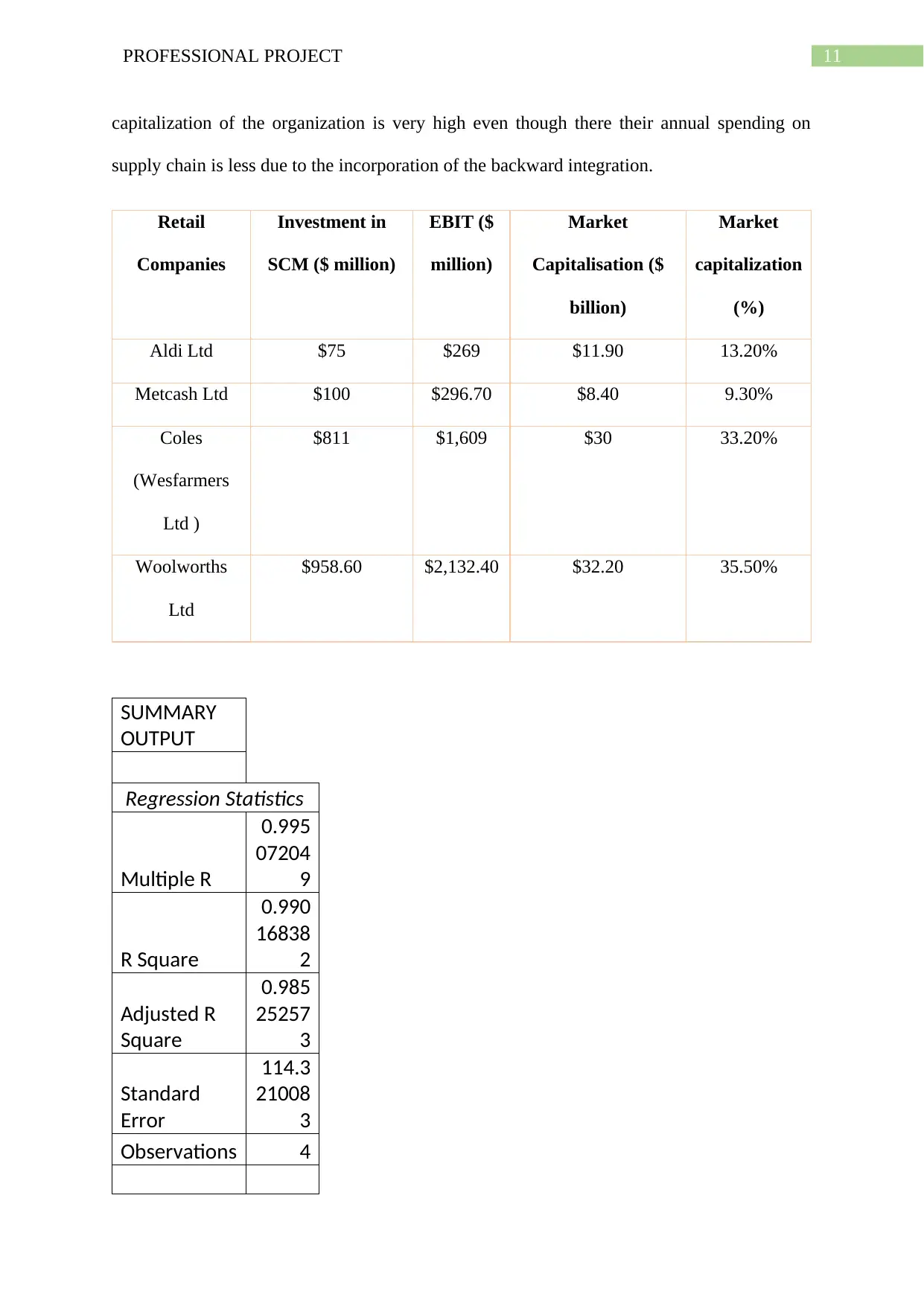
11PROFESSIONAL PROJECT
capitalization of the organization is very high even though there their annual spending on
supply chain is less due to the incorporation of the backward integration.
Retail
Companies
Investment in
SCM ($ million)
EBIT ($
million)
Market
Capitalisation ($
billion)
Market
capitalization
(%)
Aldi Ltd $75 $269 $11.90 13.20%
Metcash Ltd $100 $296.70 $8.40 9.30%
Coles
(Wesfarmers
Ltd )
$811 $1,609 $30 33.20%
Woolworths
Ltd
$958.60 $2,132.40 $32.20 35.50%
SUMMARY
OUTPUT
Regression Statistics
Multiple R
0.995
07204
9
R Square
0.990
16838
2
Adjusted R
Square
0.985
25257
3
Standard
Error
114.3
21008
3
Observations 4
capitalization of the organization is very high even though there their annual spending on
supply chain is less due to the incorporation of the backward integration.
Retail
Companies
Investment in
SCM ($ million)
EBIT ($
million)
Market
Capitalisation ($
billion)
Market
capitalization
(%)
Aldi Ltd $75 $269 $11.90 13.20%
Metcash Ltd $100 $296.70 $8.40 9.30%
Coles
(Wesfarmers
Ltd )
$811 $1,609 $30 33.20%
Woolworths
Ltd
$958.60 $2,132.40 $32.20 35.50%
SUMMARY
OUTPUT
Regression Statistics
Multiple R
0.995
07204
9
R Square
0.990
16838
2
Adjusted R
Square
0.985
25257
3
Standard
Error
114.3
21008
3
Observations 4
⊘ This is a preview!⊘
Do you want full access?
Subscribe today to unlock all pages.

Trusted by 1+ million students worldwide
1 out of 18
Related Documents
Your All-in-One AI-Powered Toolkit for Academic Success.
+13062052269
info@desklib.com
Available 24*7 on WhatsApp / Email
![[object Object]](/_next/static/media/star-bottom.7253800d.svg)
Unlock your academic potential
Copyright © 2020–2025 A2Z Services. All Rights Reserved. Developed and managed by ZUCOL.




